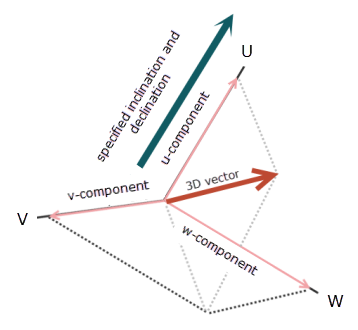Convert Vector Voxel to Voxels
Use the Vector Voxel to Voxels option (geogxnet.dll(Geosoft.GX.VoxUtils.ConvertVectorVoxelToVoxels;Run)*) from the Voxel > Conversions menu, to disassemble a vector voxel into 3 magnitude voxel models.
Vector Voxel to Voxels dialog box options
|
Input vector voxel file |
The Geosoft vector voxel file to be disassembled into its 3 components (see Application Notes). Script Parameter: ConvertVectorVoxelToVoxels.INPUTVECTORVOXEL |
||||
|
|
Project the vector voxel along the mutually orthogonal X, Y & Z axes of the standard Cartesian coordinate system. Script Parameter: ConvertVectorVoxelToVoxels.CARTESIANROTATED (0:Cartesian) |
||||
|
|
If the input vector voxel file is aware of its rotated coordinate system direction (see Application Notes), this option will also be enabled and set as the default. Otherwise it remains disabled. If present, the rotated coordinate system direction is displayed. Script Parameter: ConvertVectorVoxelToVoxels.CARTESIANROTATED (1:Rotated)
|
||||
| The next 3 entries are context sensitive. If the Cartesian coordinate system has been selected you will be prompted for the [X, Y, Z] voxel file names. If the Rotated coordinate system has been selected you will be prompted for the [U, V, W] voxel file names (see Application Notes) | |||||
|
[X|Y|Z] voxel file |
These output voxel files represent the magnitude of the vector voxel, projected onto the 3 orthogonal Cartesian axes X, Y, Z. By default these output files acquire the name of the input vector voxel file, appended by _X, _Y, _Z respectively. Script Parameters: X-> ConvertVectorVoxelToVoxels.OUTPUTVOXELX Y-> ConvertVectorVoxelToVoxels.OUTPUTVOXELY Z-> ConvertVectorVoxelToVoxels.OUTPUTVOXELZ |
||||
|
[U|V|W] voxel file |
The vector voxel is disassembled in the rotated system's components U, V, W. By default these files acquire the name of the input vector voxel file, appended by _U, _V, _W respectively. Script Parameters: U-> ConvertVectorVoxelToVoxels.OUTPUTVOXELX V-> ConvertVectorVoxelToVoxels.OUTPUTVOXELY W-> ConvertVectorVoxelToVoxels.OUTPUTVOXELZ |
Application Notes
A vector voxel is a voxel model represented by 3 scalar values at each voxel point. These values define the 3 scalar components of a vector. A vector voxel model is displayed in the 3D viewer with directional arrows; the size and colour of which are indicative of the magnitude.
A vector voxel can be disassembled into its 3 components in the standard Cartesian coordinate system, or a rotated coordinate system. In the standard Cartesian coordinate system, the projected voxels are denoted as the X, Y, & Z component voxels. The X component is analogous to Easting, the Y component analogous to Northing and the Z component direction is upwards positive. In the rotated coordinate system, the projected components are denoted as U, V, & W. The U component is positive in the direction of the rotated coordinate system’s inclination and declination, the V and W components are perpendicular to U and to each other.
If the rotated coordinate system direction is embedded in the vector voxel file (i.e. the output of a VOXI Magnetization Vector Inversion) you will be given the option to choose between the above two coordinate systems, otherwise you will only be able to project the vector voxel onto the standard Cartesian coordinate system.

Figure 1: 3D Vector displayed with respect to Cartesian coordinates; Z is upwards positive

Figure 2: 3D vector displayed with respect to rotated coordinates; U is positive in the direction of the specified inclination and declination
If a 3D Viewer is open when running the conversion, the output vector voxel will be displayed in the 3D Viewer window. Otherwise, the output voxel will be displayed into a new Voxel Viewer window. If the output voxel does not display, open the 'Advanced Settings' dialog (Project > Settings > Advanced) and under the Voxel Settings section, check if the 'Display Created Voxels' option is set to "True".
Access Seequent Online Learning and select the VOXI guided paths to learn more about effective workflows and key concepts.
See Also:
Got a question? Visit the Seequent forums or Seequent support
© 2023 Seequent, The Bentley Subsurface Company
Privacy | Terms of Use

 Cartesian
Cartesian Rotated
Rotated Inclination
Inclination